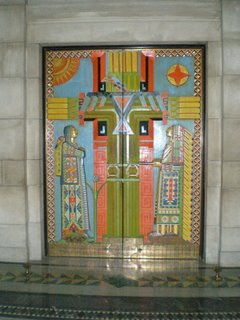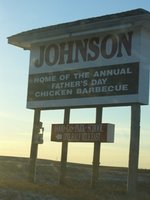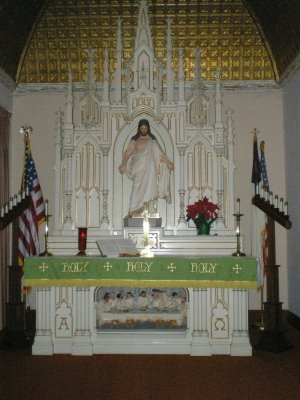Addrianne and I spent the night at Pastor Barbara's parsonage because it had internet access (very useful when doing a blog) and it was closer to the conference that we were going to today. This morning she gave us enough copies of Salem Lutheran's cookbook for our whole group and drove us to Aurora for the conference.
After arriving, we signed in, got name tags, and were fed coffee and donuts. The conference was kicked off with worship, which I quite enjoyed. (I'm not sure if it's due to their dedication to the subject at hand or a matter of most of them having voices that are vastly superior to mine (Sorry, future congregation!), but groups made up of clergy and dedicated lay people always seem to do a beautiful job of hymns.)
The keynote was given by Pastor Steve Tjarks. I enjoyed listening to him. He was an engaging speaker and made several interesting points.
1) Unlike business, the success of a church isn't about quantity, but quality. It's not about how many people you can get in the door, but the quality of the spiritual life there.
2) Rural ministry is all about programs, but about relationship. A rural pastor doesn't succeed by offering all the latest, greatest programs, but by loving and being in relationship with the congregation. A congregation can sense if you love them or are just putting your three years in before going on to something bigger and better.
3) More and more people who are coming to rural ministry are not from rural backgrounds. They feel frustrated and isolated by things and ways of being that they don't understand. Their rural congregations need to be very intentional about making them less isolated (invite them over for the holidays, introduce their kids to other kids their age in the community) and explaining things to them. Their families are also fish out of water, and you need to help them too if you want the pastor and their family to stay. An example: a new pastor came home and couldn't find his family, who had been unpacking when he left. He eventually found them huddled under blankets in a corner of the basement, trembling in fear, because they had mistaken the local lunch whistle for a tornado warning.
He made other interesting points, but I'm too tired to remember them without my notes right now, so you'll just have to trust me on that one. However, I did enjoy, and received his permission to reproduce here, his signs that you might be a rural minister.
The following section is copied straight from a presentation given by Pastor Steve Tjarks at the Nebraska Rural Ministry Task Force Rural Ministry Workshop at Messiah Lutheran Church in Aurora, Nebraska on 1/20/06.
If you are a clergy-person, here are the top 10 signs that you might be a rural pastor.
10) All meetings start later in the summer than in the winter.
9) Poisoning the ground squirrels inhabiting church property poses no moral dilemma for any church council member.*
8) You live on a gravel road, and it's better than many paved roads in the area.
7) Your closest neighbors are accurately termed "livestock".
6) Your church doors are never locked, and no one knows where the keys might be.
5) It is assumed that riding in a combine with one of your members is "real ministry."
4) The parsonage has always been, and will always be, white; both inside and out.
3) The local coffee shop sells gas, oil, tires, livestock feed, ag chemicals, and fertilizer; and the coffee is free. Drinking coffee in this location is considered legitimate ministry.
2) The church cemetery has at least one former pastor buried in it.
1) Your members' stock trailers have never been cleaner than the day they moved you into the parsonage.
Then we had a chance to talk to Bishop David deFreese, head of the Nebraska Synod, over lunch, which included cherry cobbler with vanilla ice cream for dessert. (All I can say is that if hospitality can be measured by the desire to feed one's guests, Nebraska must be trying to set the gold standard.) All of the pastors we've talked to while we've been here keep saying good things about him, and it's easy to see why, with his personable manner and good listening skills. He asked us about rural immersion, what worked, what didn't (even taking notes) and listened to our answers. He also talked a bit about rural ministry, emphasizing how, especially in the rural church, it's all about relationship.
After that we attended two sessions of our choice. I (and Adrianne) chose to attend sessions on Ministry with the Aging and then one on Worship. They were interesting, but at this point, I've hit the trifecta of tired, cranky and unable to remember what I'm writing about, so I had better wrap this up.
When the conference was over, we got into the car to try to race the snow to our next destination, and the sky was as white as the ground.

We arrived at our destination, the Carol Joy Holling Center, without incident. This center, located in Ashland, is the headquarters of Nebraska Lutheran Outdoor Ministries. It's supposed to be beautiful here, but with the cold and the darkness, I am yet to verify this (but I can verify the existence of chocolate almond tart).
Anyway, if this publishes successfully, instead of disappearing, I'm off to bed. I can leave the important things like lounging around and admiring nature from a comfy chair for tomorrow.
*This reminds me of the one of my favorites, the Lutheran squirrel joke. Have you heard it?
There were four country churches in a small Texas town: the Presbyterian church, the Baptist church, the Lutheran church, and the Catholic church. Each church was overrun with pesky squirrels.
One day, the Presbyterian Church called a meeting to decide what to do about the squirrels. After much prayer and consideration they determined that the squirrels were predestined to be there and they shouldn't interfere with God's divine will.
In the Baptist church, the squirrels had taken up habitation in the baptistry. The deacons met and decided to put a cover on the baptistry and drown the squirrels in it. The squirrels escaped somehow and there were twice as many there the next week.
The Catholic church got together and decided that they were not in a position to harm any of God's creation. So, they humanely trapped the squirrels and set them free a few miles outside of town. Three days later, the squirrels were back.
But the Lutheran church came up with the best and most effective solution. They baptized the squirrels and registered them as members of the church. Now they only see them on Christmas and Easter.

















